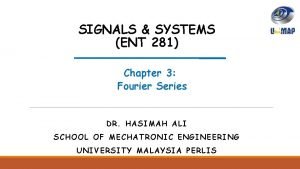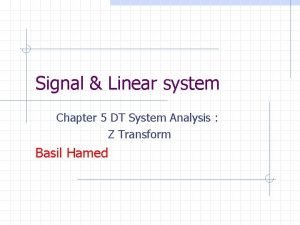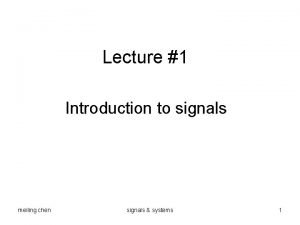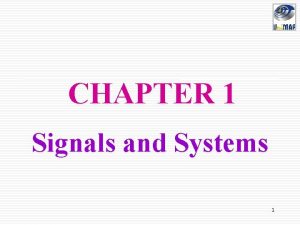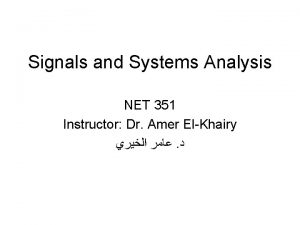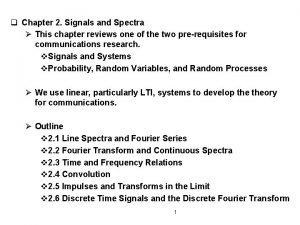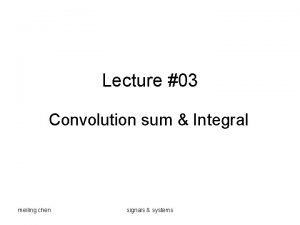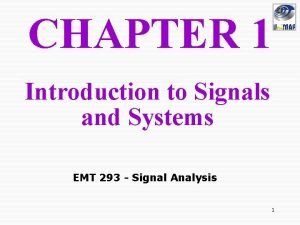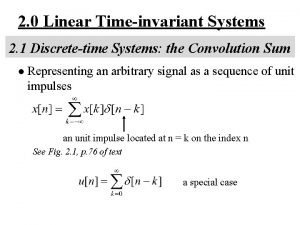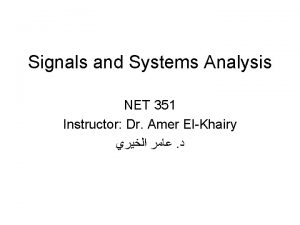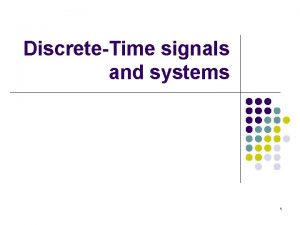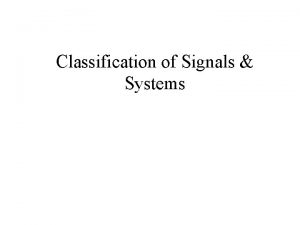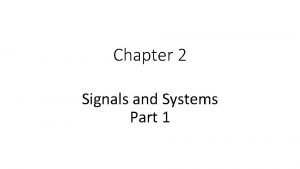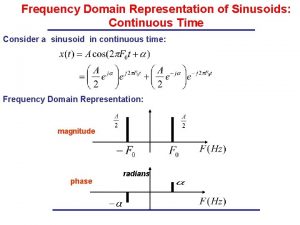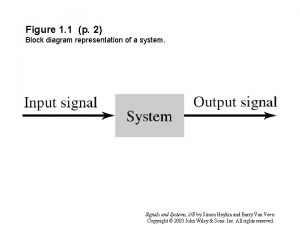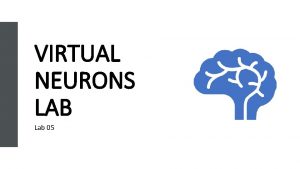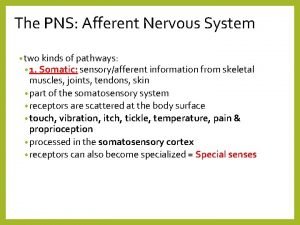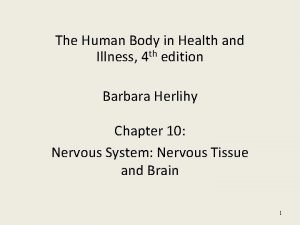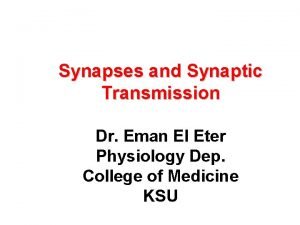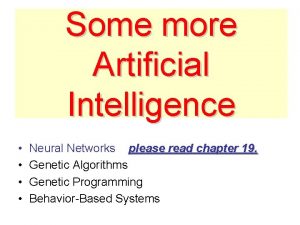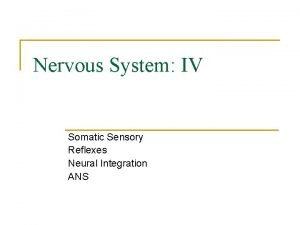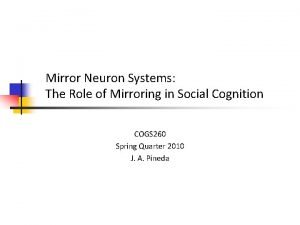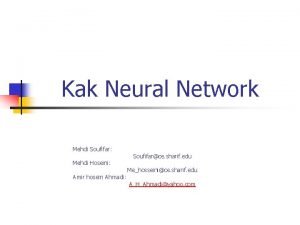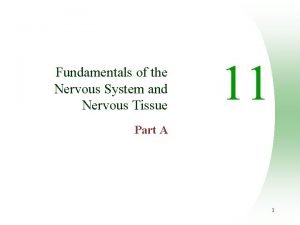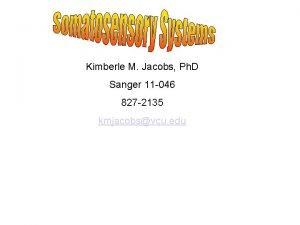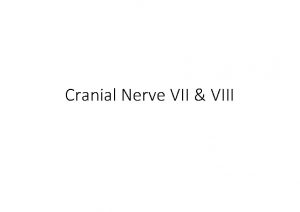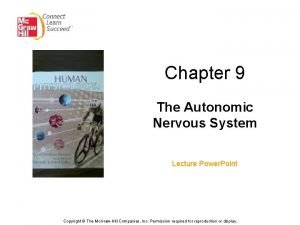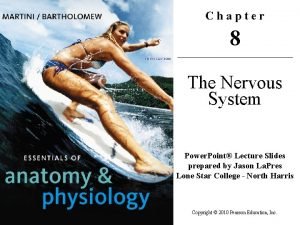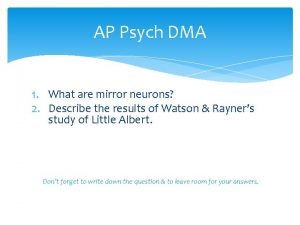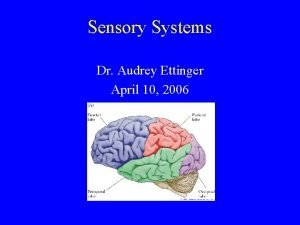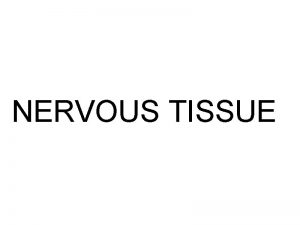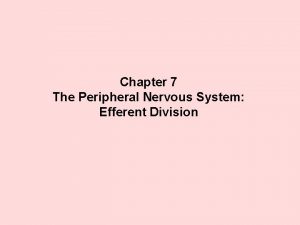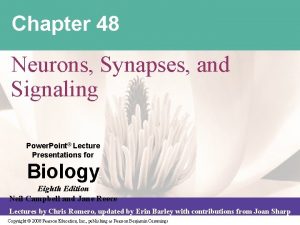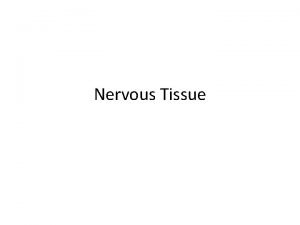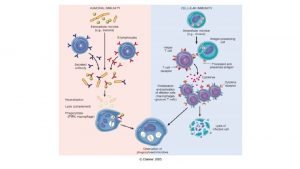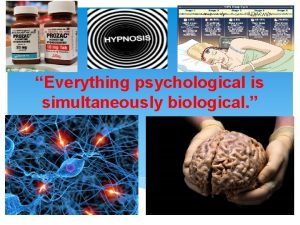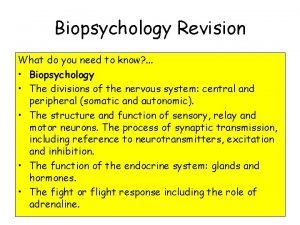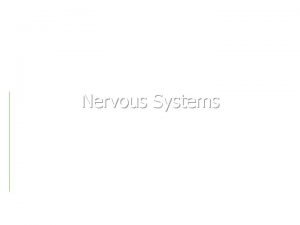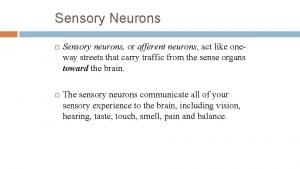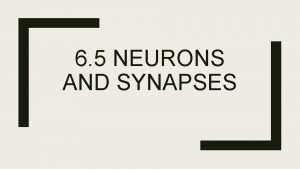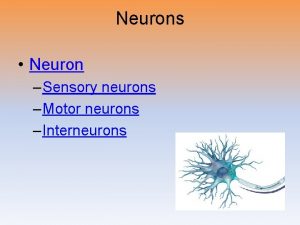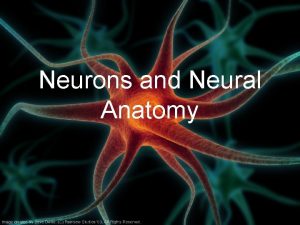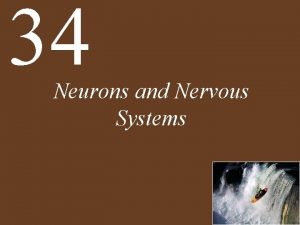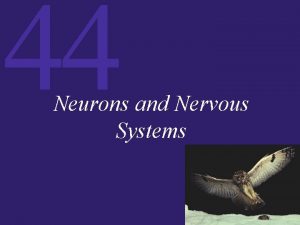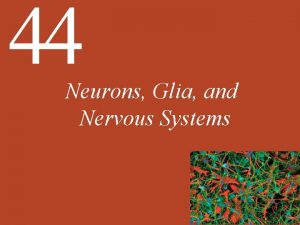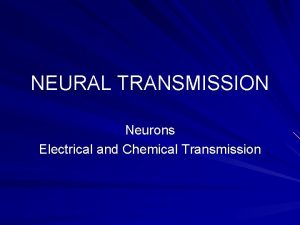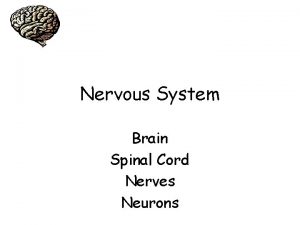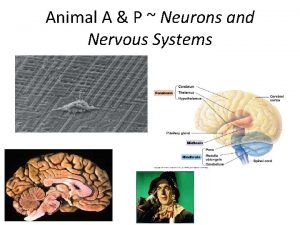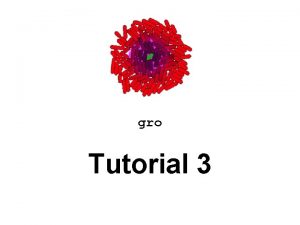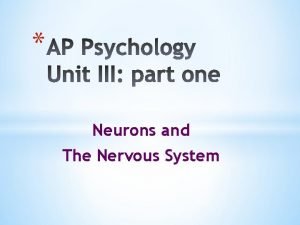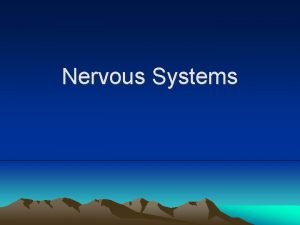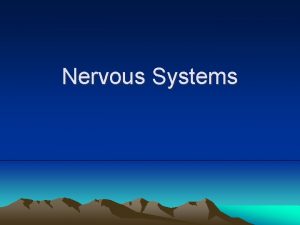Nervous Systems Nervous Systems Neurons Neural Signals Action
















































- Slides: 48

Nervous Systems

Nervous Systems

Neurons

Neural Signals • Action Potential • Membrane Potential • Sodium-Potassium Pump vs. Resting * Potential

Threshold Potential

Resting State (1) * • Both sodium • and potassium activation gates are closed Interior of cell is negative

Depolarization State (2) * • Sodium • activation gates are opened on some channels Interior of cell becomes more positive

Rising Phase of Action Potential (3) * • Most sodium • activation gates are opened Potassium activation gates are still closed

* Falling Phase of Action Potential (4) • Inactivation • • gates on sodium channels are closes Activation gates on potassium channels are opened interior of cell becomes more negative

Undershoot (5) * • Sodium • • channels are closed Potassium channels are closing Membrane returns to its resting state

Propagation of the Action Potential • Localized event • First action • potential’s depolarization sets off second action potential Travels in one direction due to refractory ______ period

Chemical Synapse

Neurotransmitters LOW –PARKINSON’S Runner’s High – inhibit GABA, increase Dopamine HIGH - SCHIZOPHRENIA Sleep, Mood, Learning Aggression, Serial Killers Low Levels LOW - SCHIZOPHRENIA

Postsynaptic Potentials IPSP – Inhibitory Post-Synaptic Potentials EPSP – Excitatory Post-Synaptic Potentials

Postsynaptic Potentials • Subthreshold – doesn’t reach threshold Temporal Summation • _____ – two signals do not reach threshold level but occur close enough to set off action potential Spatial • _____ Summation – two signals are set off at the same time setting off an action potential • Spatial Summation with an inhibitor – doesn’t reach threshold

Vertebrate Nervous System

Vertebrate Brains

Peripheral Nervous System

Peripheral Nervous System Autonomic • ______ Nervous System regulates the internal environment (usually involuntary) Somatic • ______ Nervous System regulates the external environment (usually voluntary)

Autonomic Nervous System • Sympathetic Division – Flight or fight response • Parasympathetic Division – Rest or digest response

KNOW THIS CHART! * Autonomic Nervous System

Brain

The Brainstem • The Medulla Oblongata and the Pons controls breathing, heart rate, digestion • The Cerebellum controls coordination of movement and balance (not really part of the brain stem) *

The Midbrain • The Midbrain receives, integrates, and projects sensory information to the forebrain *

The Diencepholon • Forebrain – Epithalamus • Includes the pineal gland the choroid plexus – Thalamus • conducts information to specific areas of cerebrum Hypothalamus – _______ • produces hormones and regulates body temperature, hunger, thirst, sexual response, circadian rhythms *

The Telencepholon • Cerebrum – with cortex and corpus callosum • higher thinking *

Cerebrum (KNOW THIS FIG!)

Cerebrum

Memory • Short Term – Done in the frontal lobe • Long Term – Frontal lobes interact with the Hippocampus _____ and the Amygdala ______ to consolidate

“Brainbow” Technology • Insert genes into DNA. • When expressed, some cell types become colorful. • Can see what is connected. Used to show learning. • Can trace short-and-long range connections in brain circuits

Can measure activity in a neuron

Brain-Machine Interface Braingate Neural Interface System

Monkey using brain to move robotic arm

ersity of Pittsburgh

Nutritional Requirements • Undernourished – not enough calories • Overnourished – too many calories Malnourished • ______ – missing one or more essential nutrients

Essential Nutrients • Essential Amino Acids • Essential Fatty Acids • Essential Vitamins • Essential Minerals

Essential Amino Acids • Found in proteins – 20 different types • 8 essential in adult humans (9 infants) • all in animal proteins • vegetarians need to eat grains and beans

Histidine _____ – Essential in infants

Essential Fatty Acids • Unsaturated fatty acids – used to make phospholipids for membranes

Essential Vitamins • Fat Soluble – stored in fat D, A, K, E – ______ • Water Soluble – excreted in urine – B complex and C

Essential Minerals • Inorganic nutrients – Calcium & Phosphorous • bones – Iron • anemia – Iodine • thyroid hormones – Sodium, Chlorine, & Potassium • nerve function, water regulation

Intracellular Digestion • Inside cells • All animals • Exclusive in: – Protista – Porifera

Extracellular Digestion • Outside cells • All animals above the sponges • Two Types Gastrovascular Cavity – _________ Alimentary Canal – _________

Gastrovascular Cavity • One opening • Found in Cnidaria and Platyhelminthes

Alimentary Canal • Two openings • Allows for specialization – – – – Mouth Pharynx Esophagus Crop Gizzard Stomach Intestine Anus


Digestive Tracts • Carnivores shorter – ____ digestive system – small cecum • Herbivores Longer – ____ digestive system – large cecum

 Communicative signals and informative signals
Communicative signals and informative signals Arbitrariness in human language and animal language
Arbitrariness in human language and animal language Communicative signals and informative signals
Communicative signals and informative signals Neuronal pool
Neuronal pool Fundamentals of the nervous system and nervous tissue
Fundamentals of the nervous system and nervous tissue Neuron processes
Neuron processes Parseval identity
Parseval identity Signals and systems oppenheim solutions chapter 5
Signals and systems oppenheim solutions chapter 5 Signals
Signals Precedence rule in signals and systems
Precedence rule in signals and systems Convolution sum in signals and systems
Convolution sum in signals and systems Synthesis equation fourier series
Synthesis equation fourier series Convolution sum signals and systems
Convolution sum signals and systems Introduction to signals and systems
Introduction to signals and systems Convolution sum in signals and systems
Convolution sum in signals and systems Sinusoidal signal
Sinusoidal signal Signals and systems
Signals and systems Tri function
Tri function Signals and systems
Signals and systems Parseval's theorem in signals and systems
Parseval's theorem in signals and systems Signals and systems
Signals and systems Virtual neurons
Virtual neurons Type 1 cutaneous mechanoreceptors
Type 1 cutaneous mechanoreceptors Homunculus
Homunculus Via optica
Via optica Synapse ppt
Synapse ppt Input neurons
Input neurons Somatic motor cortex
Somatic motor cortex Supraspinal
Supraspinal Proprioception autism
Proprioception autism Mirroring 260
Mirroring 260 Input neurons
Input neurons Convergence vs divergence neurons
Convergence vs divergence neurons Pyramidal tract
Pyramidal tract Fourth order neurons
Fourth order neurons Cranial vii
Cranial vii Preganglionic fibres
Preganglionic fibres Figure 8-2 neurons and neuroglia
Figure 8-2 neurons and neuroglia Mirror neurons ap psych
Mirror neurons ap psych Characteristics of sensory neurons
Characteristics of sensory neurons What are neurons composed of
What are neurons composed of Junction between two communicating neurons
Junction between two communicating neurons Efferent motor neurons
Efferent motor neurons Chapter 48 neurons synapses and signaling
Chapter 48 neurons synapses and signaling Unipolar neurons are found in
Unipolar neurons are found in Myelinzation
Myelinzation Everything psychological is simultaneously biological
Everything psychological is simultaneously biological Sensory modality examples
Sensory modality examples Three types of neurons
Three types of neurons






